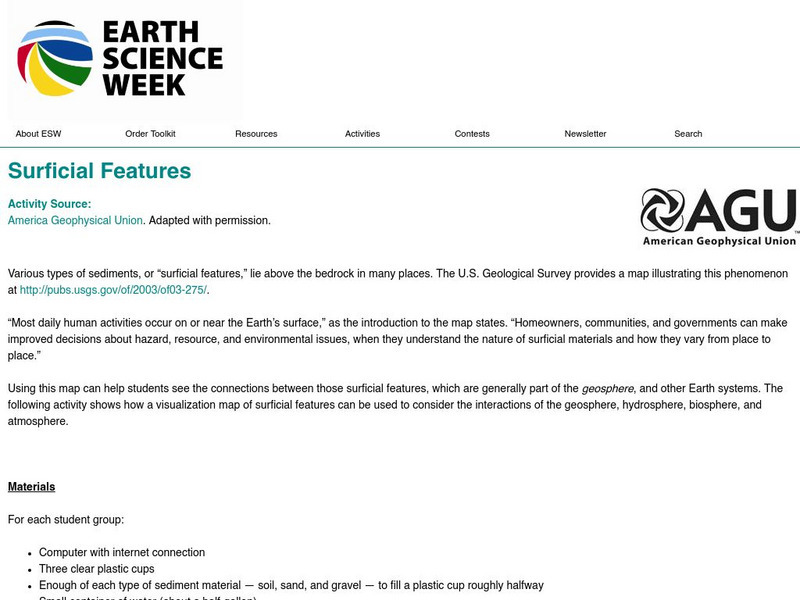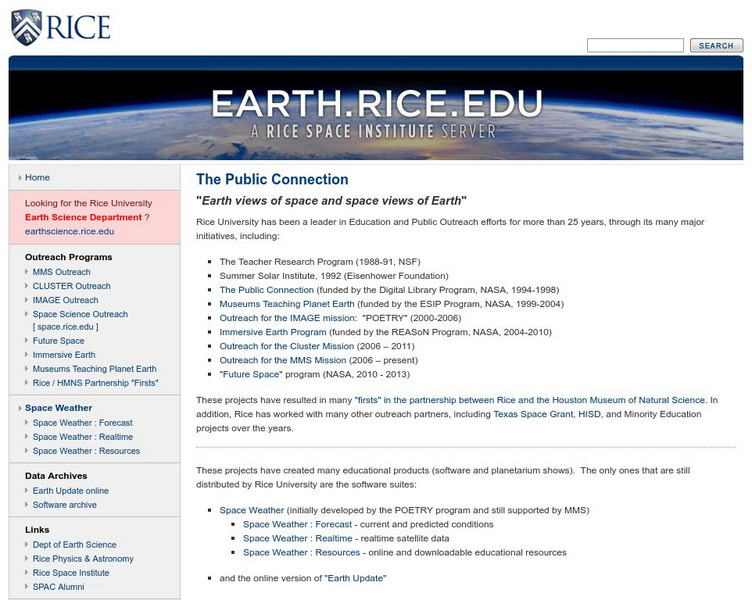Hi, what do you want to do?
Curated OER
Clouds as Art: Torn Paper Landscape
Students create a torn paper landscape and use it to study clouds. In this cloud study and art lesson, students make a background art image from torn paper. Students create a torn paper landscape and use cotton balls to illustrate...
Curated OER
Six Dynamic Designs for Arts Integrated Curriculum
Students create a recipe for a certain aspect of a culture. They create a culture that has never existed before. They analyze either dance, history, geography, history or the future of space exploration. They compare and contrast...
Curated OER
Photosynthetically Available Radiation (PAR) Measurements Part 1: Calculating the Solar Constant using a TI-8
Twelfth graders are introduced to the term Photosynthetically Available Radiation. In groups, they participate in an experiment to determine how ecosystems survive the conditions in the Arctic. They calculate the amount of solar energy...
CPALMS
Florida State University Cpalms: Florida Students: Earth's Spheres
Check out the tutorial which introduces the Earth's spheres. Viewers should be able to identify the Geosphere, Biosphere, Atmosphere, Hydrosphere and Cryosphere and know their differences and similarities.
Center for Educational Technologies
Classroom of the Future: Earth Spheres
Everything in Earth's system can be placed into one of four major subsystems: land, water, living things, or air. These four subsystems are called "spheres." Specifically, they are the "lithosphere" (land), "hydrosphere" (water),...
The Wonder of Science
The Wonder of Science: 5 Ess2 1: Earth Sphere Interactions
Fifth graders develop a model using an example to describe ways the geosphere, biosphere, hydrosphere, and/or atmosphere interact.
American Geosciences Institute
American Geosciences Institute: Earth Science Week: Surficial Features
Using a surficial features map, students see the connections between those features and other Earth systems. They will consider the interactions of the geosphere, hydrosphere, biosphere, and atmosphere.
Georgia Department of Education
Ga Virtual Learning: Astronomy: The Earth
In this interactive tutorial students will learn what causes the seasons, diurnal cycles and how the constellations move through the sky. Learn we are able to see other planets and how astronomical events affected life on the Earth.
California State University
Csu: The Sourcebook for Teaching Science: Earth Systems Interactions
Explains what the four spheres of the Earth are and describes how volcanic eruptions affect the different spheres. Also provides a list of events that are examples of interactions.
US Geological Survey
Usgs: All of Earth's Water in a Single Sphere!
See how all of Earth's water compares to the total size of the Earth.
Rice University
Museums Teaching Planet Earth: What Is the Geosphere?
Describes Earth's layers, which make up the geosphere.
CK-12 Foundation
Ck 12: Earth Science: Earth's Shape
[Free Registration/Login may be required to access all resource tools.] Examines Earth's shape.
Rice University
Museums Teaching Planet Earth: Hydrosphere
This tutorial looks at the hydrosphere, that component of the earth that is liquid water such as rivers, streams, oceans, and so on.
eSchool Today
E School Today: Earth System
Learn about the systems that make up Earth, and find out how they interact.
Center for Educational Technologies
Nasa: Classroom of the Future: Spheres Atmosphere
Atmosphere is briefly discussed here as one of earth's "spheres."
University of California
Ucmp: Creating an Earth System: Interactions in the Earth System
A brief description of the four spheres of the Earth, with an activity where students brainstorm interactions among them.
Center for Educational Technologies
Exploring the Environment: Earth System Science
Explains what the four spheres of the Earth are, and the interactions between them.
Center for Educational Technologies
Nasa: Classroom of the Future: Spheres: Lithosphere
At this site from the NASA Classroom of the Future, you can learn about the many different layers of the earth and see what the earth would look like cut in half.
Center for Educational Technologies
Nasa: Classroom of the Future: Spheres: Hydrosphere
Use this site to learn about the millions and trillions of gallons of water that covers the earth, known as the hydrosphere.
NASA
Nasa: Visible Earth
From NASA, "Images, visualizations, and animations," that students will find extremely interesting and helpful in their study of the earth. Includes pictures of environmental impacts, erosion, coastal processes, atmosphere, and lots more.
Other
Face of the Earth: Matching Game
Matching game on the earths core and crust. Students test their knowledge and learn what is below the earth's surface.
E-learning for Kids
E Learning for Kids: Science: Greece: What Is the Earth Made Of?
Dionysus is a Greek God. and a theater director. Help him get ready for the play and learn about land, water, and air. After completing this lesson, students should be able to identify the different materials Earth is made up from (land,...
Science Education Resource Center at Carleton College
Serc: Earth System Science
Students learn to identify the parts of the Earth system and the processes that connect them. They look for interconnections among components of the Earth system at the local level, using a study site close to their school.
National Association of Geoscience Teachers
Nagt: Earth System Science Project
An Earth System Project shows the interaction between the Geosphere, Hydrosphere, Atmosphere, and Biosphere. This project provides a model of a pond ecosystem and can easily be woven into the hydrosphere unit.
Other popular searches
- Spheres of the Earth
- Four Spheres of Earth
- Spheres of Earth
- Spheres of Earth Activity
- Spheres of Earth Acidity
- Identify Spheres of Earth
- Spheres of Earth Acitity


























